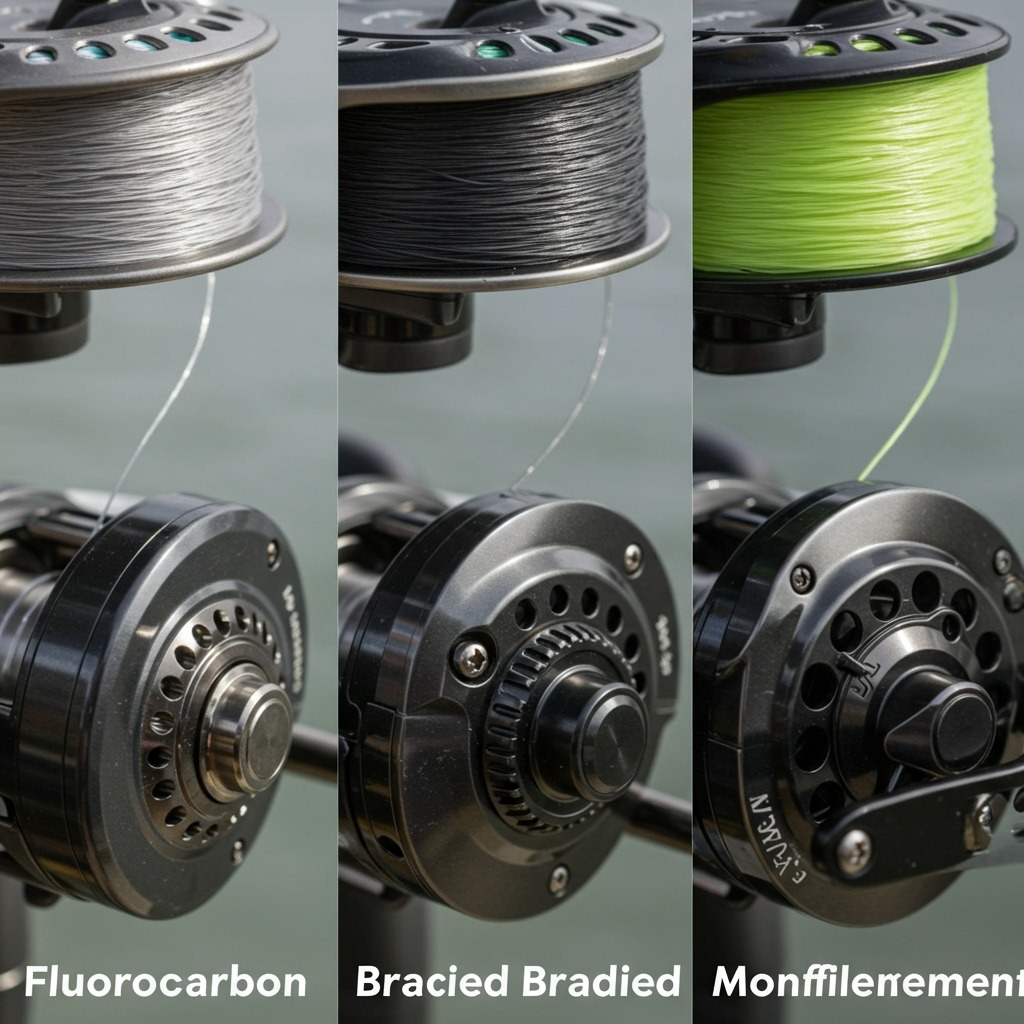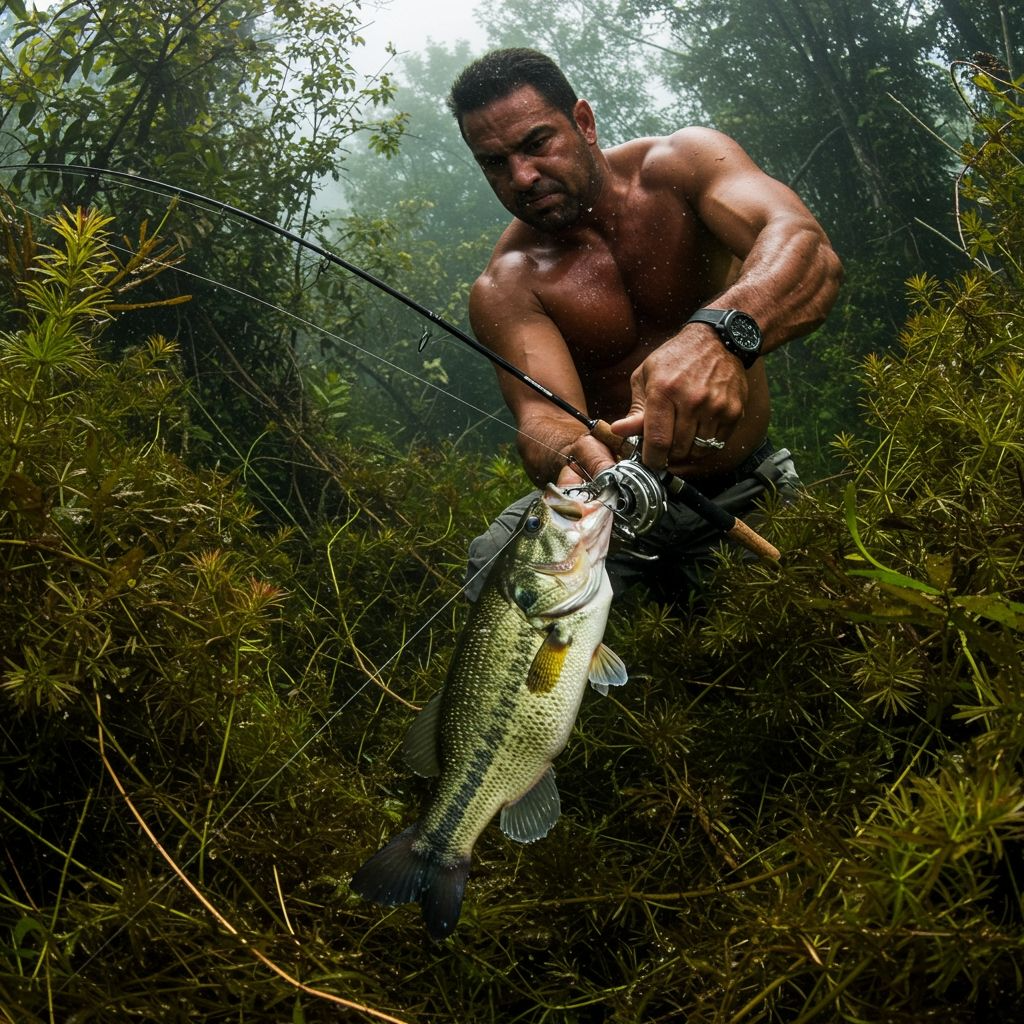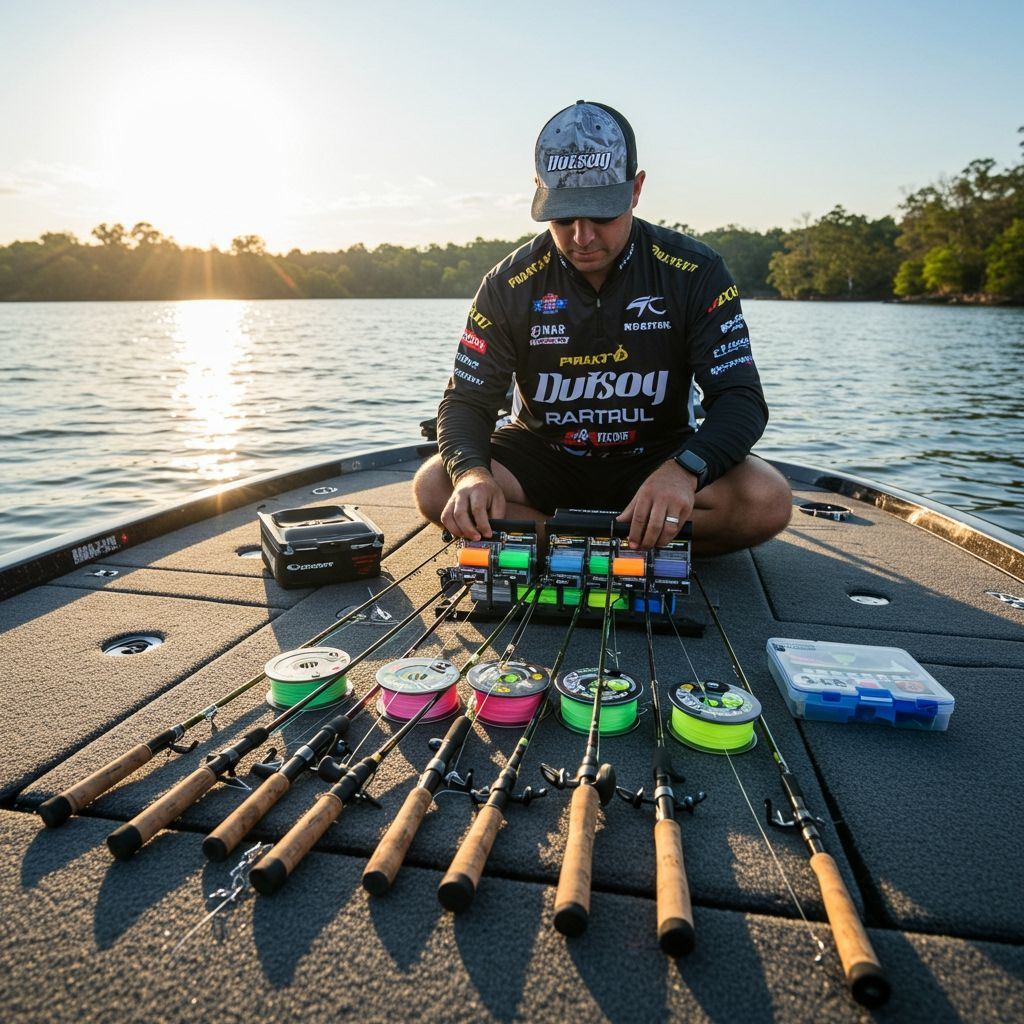Last spring, I was struggling on a heavily pressured lake in Alabama, working a topwater frog over thick grass mats. Despite perfect conditions and active fish, I kept losing quality bass during the fight. That’s when an old-timer showed me something that revolutionized my bass fishing – the importance of matching your fishing line to specific techniques and conditions.
The best fishing line for bass isn’t just about buying the most expensive option. It’s about understanding how different line types perform in various situations and matching them to your fishing style. Whether you’re flipping heavy cover, finesse fishing in clear water, or working topwater lures, your line choice can mean the difference between landing trophy bass and telling stories about “the one that got away.” Understanding proper line selection is as crucial as mastering bass fishing fundamentals.
Understanding Bass Fishing Line Types
Modern bass fishing revolves around three main line types: fluorocarbon, braided line, and monofilament. Each offers distinct advantages that make them ideal for specific techniques and conditions.
Fluorocarbon excels in clear water situations due to its near-invisibility underwater. Its low stretch provides excellent sensitivity for detecting subtle bites, while its abrasion resistance handles rocky structure and heavy cover well.
Braided line delivers an unmatched strength-to-diameter ratio and zero stretch for maximum sensitivity. Its thin diameter cuts through vegetation, making it perfect for heavy cover techniques and long-distance casting.
Monofilament offers stretch that acts as shock absorption during fights, plus buoyancy that keeps topwater lures on the surface. Its affordability and versatility make it an excellent all-around choice.
The key to bass fishing success lies in matching these characteristics to your specific fishing situations rather than relying on a single line type for everything.

Best Fluorocarbon Lines for Bass
Seaguar Tatsu Fluorocarbon: Premium Performance
Seaguar Tatsu stands as the gold standard for fluorocarbon bass fishing lines. Its double-structure construction provides exceptional sensitivity while maintaining superior abrasion resistance. This line excels for finesse techniques like drop shots, Carolina rigs, and jerkbaits.
Key advantages:
- Exceptional sensitivity for detecting light bites
- Superior abrasion resistance around the structure
- Nearly invisible underwater in clear conditions
- Excellent knot strength and castability
Best applications: Clear water finesse fishing, jerkbaits, Texas rigs around structure
Seaguar Red Label: Best Budget Fluorocarbon
For anglers seeking quality fluorocarbon without premium pricing, Seaguar Red Label delivers outstanding value. While slightly thicker than premium lines, it provides reliable performance across various bass fishing techniques.
Why it works:
- Strong and dependable for heavy cover fishing
- Good sensitivity for the price point
- Smooth casting with minimal memory
- Versatile enough for multiple techniques
Ideal for: Budget-conscious anglers, beginners learning fluorocarbon techniques, general bass fishing applications
Understanding proper rigging techniques becomes as important as line selection, much like learning how to tie fishing line correctly for maximum strength and reliability.
Best Braided Lines for Bass
PowerPro Spectra: Time-Tested Reliability
PowerPro Spectra has earned its reputation through decades of proven performance in bass fishing applications. Its consistent diameter and smooth casting make it a favorite among tournament anglers.
Standout features:
- Exceptional strength-to-diameter ratio
- Smooth, round construction for easy casting
- Excellent durability and UV resistance
- Available in multiple colors for different conditions
Perfect for: Flipping and pitching, frogging, spinnerbaits, deep cranking
Sufix 832 Advanced Superline: Maximum Durability
When fishing demands extreme strength and abrasion resistance, Sufix 832 delivers with its 8-carrier construction and GORE Performance Fibers.
Advantages:
- Superior abrasion resistance for heavy cover
- Excellent casting distance and accuracy
- Strong knot strength with proper tying techniques
- Long-lasting durability reduces replacement frequency.
Best uses: Heavy cover flipping, vegetation fishing, structure fishing with moving baits

Best Monofilament Lines for Bass
Berkley Trilene XL: Versatile All-Around Choice
Berkley Trilene XL provides the smooth casting and reliability that have made it a staple in tackle boxes for generations. Its balanced stretch and strength make it ideal for multiple bass fishing techniques.
Key benefits:
- Smooth casting with minimal memory
- Excellent shock absorption during fights
- Good knot strength and easy tying
- Affordable pricing for frequent replacement
Ideal applications: Topwater fishing, crankbaits, spinnerbaits, beginner techniques
Sufix Elite: Premium Monofilament Performance
For anglers seeking premium monofilament performance, Sufix Elite offers advanced technology in a traditional line format.
Advanced features:
- G2 Precision Winding eliminates memory
- J7 Micro Resin enhances strength and sensitivity.
- Lower stretch than standard monofilament
- Excellent castability and manageability
Best for: Tournament fishing, clear water applications, techniques requiring precise control
Line Selection by Fishing Technique
Flipping and Pitching: Heavy Braided Line
Recommended: 50-65 lb braided line
Heavy braided line excels for flipping and pitching because its zero stretch provides immediate hook sets, while its thin diameter cuts through vegetation. The high breaking strength handles big bass in heavy cover without breakoffs.
Finesse Fishing: Light Fluorocarbon
Recommended: 8-12 lb fluorocarbon line
Fluorocarbon’s invisibility becomes crucial when targeting pressured bass with finesse techniques. Light line weights ensure natural bait presentation while maintaining sensitivity for detecting subtle bites.
Topwater Fishing: Monofilament
Recommended: 12-17 lb monofilament line
Monofilament’s buoyancy keeps topwater lures on the surface, while its stretch prevents ripping hooks from fish during explosive strikes. The shock absorption also helps land fish on treble-hooked lures.
Crankbaits: Fluorocarbon or Monofilament
Recommended: 10-15 lb fluorocarbon or monofilament
Fluorocarbon gets crankbaits deeper due to its sinking properties, while monofilament’s stretch reduces the chance of pulling hooks during a fish’s head shakes. Choose based on desired running depth and structure density.
For those exploring different bass fishing approaches, understanding fly fishing for bass requires specific line considerations that differ from conventional tackle applications.
According to Field & Stream, choosing the right fishing line ranks among the top three most important factors in bass fishing success.

Line Weight Selection for Bass Fishing
Light Line (6-10 lb test)
Best for: Clear water, finesse techniques, pressured fish
Techniques: Drop shot, shaky head, small jerkbaits, light jigs
Light line provides maximum stealth and natural presentation but requires careful fighting techniques and sharp hooks for successful hookups.
Medium Line (12-17 lb test)
Best for: Versatile fishing, moderate cover, most bass techniques
Techniques: Texas rigs, Carolina rigs, spinnerbaits, topwater, crankbaits
Medium-weight line offers the best balance of strength and versatility for most bass fishing situations while maintaining good casting distance.
Heavy Line (20+ lb test)
Best for: Heavy cover, big bass, power fishing techniques
Techniques: Flipping, pitching, frogging, swimjigs in vegetation
Heavy line provides maximum strength for wrestling bass from thick cover and handling trophy fish without concern for breakoffs.
Water Clarity and Line Choice
Clear Water: Fluorocarbon Priority
In clear water conditions, bass become extremely wary of visible fishing lines. Fluorocarbons’ refractive index closely matches water, making it nearly invisible to fish. Use the lightest weight possible while maintaining adequate strength for your technique.
Stained Water: Versatile Options
Stained water reduces line visibility concerns, allowing the use of braided line or monofilament without spooking fish. Focus on line properties that enhance your technique rather than invisibility.
Muddy Water: Braided Line Advantages
In muddy water, visibility becomes irrelevant, making braided line’s strength and sensitivity advantageous. The zero stretch helps detect bites when visual cues disappear.
Seasonal Line Considerations
Spring: Versatile Medium Lines
Spring bass fishing requires versatility as conditions and techniques change rapidly. Medium-weight fluorocarbon or monofilament handles most spring techniques effectively while providing good casting distance and control.
Summer: Structure-Focused Heavy Lines
Summer bass often relate to deep structure and heavy cover, making abrasion-resistant fluorocarbon and strong braided line essential for successful fishing.
Fall: Aggressive Technique Lines
Fall feeding activity favors aggressive techniques that benefit from the braided line’s casting distance and sensitivity. Moving baits work well with braid’s immediate hookup response.
Winter: Finesse-Focused Light Lines
Cold water bass require subtle presentations that benefit from light fluorocarbon line. The reduced visibility and sensitivity help trigger strikes from lethargic fish.

Common Line Selection Mistakes
Using Single Line Type for Everything
Many anglers stick with one line type regardless of technique or conditions. Successful bass fishing requires matching line characteristics to specific situations rather than using a “one-size-fits-all” approach.
Wrong Weight Selection
Using a line too heavy for finicky fish or too light for heavy cover reduces effectiveness significantly. Match line strength to fish behavior and cover density rather than following generic recommendations.
Ignoring Water Conditions
Failing to adjust line selection based on water clarity and structure density limits success. Clear water demands different line choices than stained or muddy conditions.
Poor Quality Line
Cheap fishing line often breaks at crucial moments, costs more in lost lures, and reduces fishing confidence. Invest in a quality line from reputable manufacturers for consistent performance.
Rod and Reel Compatibility
Spinning Reels: Lighter Lines
Spinning reels perform best with lighter lines (6-17 lb test) in monofilament or fluorocarbon. Braided line works well but may require backing or careful spooling to prevent slippage.
Baitcasting Reels: Versatile Options
Baitcasting reels handle all line types effectively, making them ideal for techniques requiring heavy line or long casts. The adjustable drag systems work well with zero-stretch braided lines.
Line Capacity Considerations
Match line capacity to your fishing style. Deep water fishing requires more line capacity than shallow cover fishing. Consider backing with a cheaper line to reach the proper capacity without excessive cost.
Understanding bass fishing success extends beyond just line selection. Learning about early spring bass fishing patterns helps you apply proper line choices during this crucial season when bass behavior changes dramatically.
Budget-Friendly Line Strategies
Main Line and Leader Systems
Use affordable braided mainline with fluorocarbon leaders to combine braid’s casting distance with fluorocarbon’s invisibility. This system reduces costs while maintaining performance advantages.
Bulk Purchasing
Buy popular line weights in bulk to reduce per-yard costs. Store properly to maintain line quality and performance over time.
Technique-Specific Spooling
Spool different reels with lines optimized for specific techniques rather than trying to make one setup work for everything. This approach improves success rates and reduces frustration.
The best fishing line for bass depends on your specific fishing situations, techniques, and conditions. Rather than searching for a single perfect line, build an arsenal of different line types that match your fishing style. Quality fluorocarbon for clear water finesse, reliable braided line for heavy cover, and versatile monofilament for topwater techniques create a complete system for bass fishing success.
Remember that line is your direct connection to the fish – invest in quality products that won’t fail during crucial moments. With proper line selection matched to your techniques and conditions, you’ll land more bass and lose fewer fish to preventable break-offs.
For additional bass fishing knowledge, exploring surf fishing techniques can provide insights into line selection principles that apply across different fishing environments. Additionally, resources from Fishing Booker offer comprehensive guides on bass fishing lines and techniques that complement proper line selection knowledge.
FAQ: Bass Fishing Line Questions
What’s the best all-around bass fishing line?
For versatility across multiple techniques, 15 lb fluorocarbon provides the best balance of strength, sensitivity, and invisibility. It handles most bass fishing situations effectively while remaining nearly invisible in clear water.
Should I use braid or fluorocarbon for bass fishing?
Use braided line for heavy cover techniques like flipping and frogging where strength matters most. Choose fluorocarbon for clear water situations and finesse techniques where invisibility and sensitivity are crucial.
What pound test line is best for bass?
Line weight depends on technique and cover density. Use 8-12 lb for finesse fishing, 12-17 lb for general techniques, and 20+ lb for heavy cover fishing. Match strength to conditions rather than following rigid rules.
How often should I change my bass fishing line?
Replace line based on use frequency and conditions. Heavy use requires monthly replacement, moderate use every 2-3 months, and light use 2-3 times per year. Always replace lines showing nicks, fraying, or reduced strength.
Is expensive fishing line worth it for bass?
Quality line prevents lost fish and lures, making it cost-effective long-term. Premium lines offer better sensitivity, casting, and durability that improve fishing success and reduce replacement frequency.
